Kamakura
 From Conservapedia
From Conservapedia This entry makes use of Japanese characters and will require Japanese language support to be installed on your computer in order to avoid the characters being replaced by question marks, or blanked out.
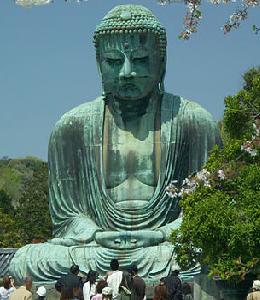
Kamakura (鎌倉市, Kamakura-shi) is a city in Japan, located 50 km south-south-west of Tokyo, in the Kanagawa prefecture. It served as the country's capital during the Kamakura Period from 1192 to 1333, being both the seat of the ruling Shogunate and the Imperial Household. Today, it is a moderately-sized city, with a population of some 170,000 inhabitants and enjoys the quiet, civilized atmosphere of an ancient city.
The Great Buddha of Kamakura is a bronze statue of Amida Buddha that is located on the grounds of the Kotokuin Temple. With a height of 13.35 meters, it is the second largest Buddha statue in Japan."[1] This bronze statue is commonly called Daibutsu.
Other attractions for tourists and pilgrims are the Tsurugaoka Hachimangu Shrine, which attracts over 2.3 million followers of the Shinto faith annually,[2] the Kinryuzan Hokaiji temple, the Asahina-Kiridoshi Pass and Egara Tenjin Shrine, all of which date back to the 11th and 12th centuries A.D.
As a coastal town, Kamakura has large beaches. The city emblem is the "Sasarindou". (The "Sasarindou" is a crest designed with bamboo grass leaves and gentian flowers.)
Contents
- 1 History
- 1.1 Minamoto Era
- 1.2 The Hojo and Kamakura Eras
- 1.3 Post-Kamakura Era
- 2 Places of Interest
- 2.1 Dankazura
- 2.2 Komachi Dori Street
- 2.3 Tsurugaoka Hachimangu Shrine
- 2.4 Kiri-doshi
- 2.5 Waka-ejima
- 2.6 Gorinto
- 2.7 Yofu'kuji
- 2.8 Kotokuin Temple
- 3 See also
- 4 External links
- 5 Notes
History[edit]
The earliest evidence of human habitation in the area now known as Kamakura is taken from pottery shards, unearthed on present-day hillsides, belonging to the Jomo period (dated by secular archaeology to 7,500 B.C. to 5,000 B.C.). The people built plain pit houses and settled on the tableland areas, utilising bows and arrows for hunting. Obsidian arrowheads found buried here are thought to have been brought from the Izu Peninsula, which would suggest trade relations existed with distant areas. Harpoon heads and fish hooks, made from the bones and horns of birds and animals, as well as sinkers or weights for fishing nets have also been found. In addition, stone plates, stone pestles, mortars, and grinding or pounding stones have been found for cracking open and grinding various kinds of nuts.
During the Yayoi period (300 B.C.-300 A.D.) the area became known for—and is distinguished by—a type of pottery distinct from that of the former period. Called Yayoi-shiki (弥生式) after the place where it was first unearthed (the Yayoi section of Bunkyo Ward, Tokyo), it is reddish-orange with a smooth finish. Bronze and iron tools came to be used, and even glass-making and weaving techniques were introduced.
At the beginning of the Yayoi period, the land began to be used for rice-paddy cultivation, recently introduced from China. This radically changed the inhabitants' way of life from hunting and gathering to farming, based primarily on rice-growing. The earliest pieces of Yayoi pottery found in Kamakura are from the Middle Yayoi period. Many Yayoi-period sites have been found in the region.
This was followed by the Kofun period (古墳時代) (300 A.D. to 700 A.D.), named after the earthen tomb mounds, which were used around this period. Comparable in scale to the Egyptian pyramids, the large mounds were built for members of the imperial and influential families. The largest remaining kofun is the Nintoku Mausoleum (仁徳稜, fifth century) in Osaka, measuring 486 meters in length.[3] Although a cluster of tomb mounds were known to have existed in Kamakura, the Wadazuka Mound (和田塚) is the only earthen tomb mound that remains to this day. Originally called the Mujodozuka Mound (無常堂塚) and clay haniwa (埴輪)—funerary objects in the shape of cylinders and horses—have been found there.
In its early years, Kamakura was originally thought to have been a nondescript fishing and farming village. Recent excavation work, however, has brought to light another aspect. It was discovered that some temples and shrines had been built in appropriate spots, and the presumption now is that large-scale, local government offices were located around Yuigahama, extending as far as the Imakoji (今小路) area in the southern part of present-day Ogigayatsu.
Minamoto Era[edit]
During the 12th century, Japan’s capital was Kyoto. During this period, civil war raged between the Minamoto and the Taira military clans. The Minamoto clan had been virtually defeated by 1159, with almost all its family members either killed or forced to take their own lives. One of the few survivors was Yoritomo Minamoto (1147-1199), a notable samurai warrior and the founder of the Kamakura Shogunate as well as the first de facto military dictator of Japan. The only legitimate child of the Minamoto clan, he was only 13 years old when his father was killed in 1160. However, instead of killing Yorimoto, the Taira clan’s chieftain banished him to the countryside of the Izu Peninsula, located some 90 kilometres south-west of Tokyo. Whilst in exile, Yoritomo married Masako Hojo (1157-1225), a daughter of a local warlord, and gradually began to garner support; a number of samurai clans from eastern Japan pledging their allegiance due to his pedigree.
At the age of 33, Yoritomo launched his first attack, at the foot of the Peninsula, against the local Taira warlords. Though defeated, news spread quickly, resulting in many Minamoto supporters, mostly in eastern Japan, declaring their allegiance to the Minamoto clan and fighting against the Taira clan. With this assistance from the provincial warlords, Yoritomo began to win ensuing skirmishes against the local factions of the Taira, eventually setting up his headquarters in Kamakura in 1180. The main reason he chose Kamakura was its strength as a natural fortress, being surrounded to the north, east and west by hills, though no higher than 150 meters, and the south bordered by the ocean, or the Bay of Sagami.
Following the establishment of his headquarters, the civil war between the Minamoto and the Taira clans intensified, as Yoritomo was joined by his cousin Yoshinaka Minamoto (1154-1184), who lived in Nagano Prefecture. He was among those who rose up in arms against the Taira clan in 1180. Yoritomo’s half-brother Yoshitsune (1159-1189), who was, at the time, based in Hiraizumi, Iwate Prefecture, under the custody of another powerful clan named Fujiwara, also joined Yoritomo's troops. This allowed Yoritomo to remain in Kamakura to oversee the war, whilst Yoshitsune and Yoshinaka outmanoeuvred the enemy and won a series of overwhelming victories, culminating with the fall of Kyoto.
By 1192, there were no longer any clans capable of matching Yoritomo's power, and the Imperial Court bestowed upon him the official title of the Supreme Commander. Thus, the first Shogunate, or the military government, started in Kamakura, with Yoritomo serving as the military and political dictator of the entire nation. He established a typical feudal system, taking care of his vassals by appointing them as provincial administrators. The government office was located east of the present-day Tsurugaoka Hachimangu Shrine. Yoritomo's reign was ended by a fall from his horse in late 1198. He never recovered and died in early 1199.
Although the rules stated that the Shogun would be succeeded by his son, Yoritomo's son Yoriie was only 17 at the time of his father's death and too young to rule effectively. This led to a power struggle between the mother's family, the Hojo's and that of his wife, the Hikis. The subsequent battle resulted in the virtual extermination of the Hikis, including Yoriie's wife and six-year-old child.
The Hojo and Kamakura Eras[edit]
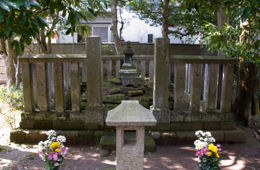
Yoritomo's widow, Masako Hojo, now wielded political power, resulting in her being named the Nun Shogun. The most important task then was to chose the next Shogun. Deciding he was the most suitable, the Hojo's appointed Kyoto aristocrat Yoritsune Kujo (1218-1256), a child with whom Yoritomo had a distant kinship. This despite the fact that he was only a one year old baby when he came to Kamakura, far too young to be the Shogun. As a result of this, the Hojo's were able to employ the regency system, with real power leaving in the hands of regents, who were chosen from amongst its own family members. The First Regent was Tokimasa Hojo (1138-1215), Masako's father, and second regency passed to Yoshitoki Hojo (1163-1224), Masako's bother, and from then onward, the regency was handed down to the legitimate sons of the Hojo family one after another until the 16th and last Regent. During the Hojo regime, which lasted for nearly 110 years from 1219 to 1333, the ruling power continued to vest with them.
In 1268, Japan was faced with unprecedented external pressures. Kublai Khan (1215-1294) the grandson of Genghis Khan (1167-1227), sent an envoy to Japan to ask the Shogunate to acknowledge the Khan's suzerainty. The Kamakura Shogunate refused. Mongolia repeatedly sent envoys thereafter, each time urging the Shogunate accept their proposal but to no avail. Finally, in 1274, a Mongol fleet of 900 ships and 33,000 troops invaded the northern part of Kyushu island. However, a typhoon struck the area in the midst of the battle, resulting in the loss of most of Mongol fleet, forcing them to retreat. Kublai sent another envoy in 1279, during the reign of Tokimune Hojo, (1251-1284), the 8th Regent. Not only did he decline the offer, but also had the Mongolian emissaries executed. This prompted the Khan to launch another attack on Fu'kuoka Prefecture in 1281, amassing a fleet of 4,000 ships and some 140,000 soldiers. Overwhelming the Japanese forcces, the Mongolian fleet reached as far as Dazaifu, 15 kilometres south of Fu'kuoka city. However, another fortuitous typhoon struck the area again, destroying the invading forces. (This gave rise to the myth of the Kamikaze (神風) or Divine Wind).

Though peace was restored, the Japanese warlords who fought against the invaders were not happy, as they had not been rewarded for their efforts. In the former domestic battles, the Shogunate had granted part of the territories obtained from the enemies as rewards to each warlord of the allies in recognition of their service rendered, however, the Kamakura Shogunate had nothing by way of land to grant, even though they won the battle. The combined disappointment of the warlords and the financial drain of the war began the decline of the Hojo dynasty.
In Kyoto, Emperor Go-Daigo (後醍醐天皇) (1318-1339) had been awaiting the opportunity to overturn the Hojo regime and reinstate direct Imperial rule, and attempted a revolt in 1324. However, details of the conspiracy reached Kamakura, and the Emperor was exiled to the same island as Emperor Go-Toba (後鳥羽天皇), in 1198. Whilst he was in exile, anti-Kamakura sentiment among the warlords continued to build, and in 1333 loyalist warlords liberated Emperor Go-Daigo. As the risk of outright rebellion grew, the Kamakura Shogunate ordered its troops to attack Kyoto. The military commander was Takauji Ashikaga (1305-1358), who had close blood-relations to the Hojos, and was their faithful retainer. In Kyoto, however, he defected to the Imperial Court, thus betraying the Hojos, and launched a counter-attack against Rokuhara, under Imperial orders. At the same time, Yoshisada Nitta (1302-1338), formed a loyalist force and attacked Kamakura directly at the command of Emperor Go-Daigo. After a fierce battle, lasting for several days, Kamakura finally surrendered and the Hojo regime was toppled, bringing about the end of the Kamakura Period.
Post-Kamakura Era[edit]
Kamakura gradually lost its importance politically as well as militarily. In the mid 15th century, it was virtually burnt to the ground by a nearby warlord. It never recovered, becoming a small rural village. During the Edo Period (1603-1868), the Tokugawa Shogunate provided financial aid to several temples and shrines, but this was not enough to restore past glories.
In the early Meiji Period (1868-1912), Kamakura was a remote, deserted rural country inhabited only by farmers and temple or shrine staff. A photograph taken near the Wakamiya Oji main street at the time shows that most of the area was covered with rice paddies, and totally different view from that seen today.
However, the coming of the railway with the opening of the Yokosuka Line in 1889 linking Tokyo to Kamakura brought a dramatic change. Kamakura returned to the spotlight, not as the capital, but as a resort town. Celebrities began to build houses here as summer getaways, due to Kamakura's convenient beach, facing the Bay of Sagami. The population continued to grow, and the city is now densely populated with 170,000 people in less than 40 square kilometres. In summer, a multitude gather here for bathing.
Today, Kamakura draws more than 17 million sightseers a year, and the city is preparing to apply to the UNESCO's World Heritage Committee for the city being registered as a World Heritage Site.
Places of Interest[edit]
Dankazura[edit]
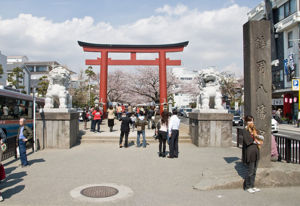
It was originally constructed at the command of Yoritomo Minamoto when his wife Masako was pregnant. At the age of 36, Yoritomo had two daughters but no son or heir apparent yet. Under the Kamakura Shogunate rule, only the eldest male child was qualified to succeed to the Shogun's post. The couple really wanted to have a baby boy and they prayed that the next child be a boy, dedicating this path to the Shrine in 1182. It was modelled after the Miyako Oji Street in Kyoto, the main boulevard of the Capital. Their prayer was answered the same year. The new-born child was a boy and named Yoriie, who later inherited the title of the Shogun. Recent excavations have revealed that the original road was quite different from that seen today. It was as wide as 33 meters, flanked on both by moats, three meters wide and 1.5 meters deep, designed to prevent enemies from breaking in. The walkway stretched from the first torii gate near the beach, up to the third one, covering a distance of 1,500 meters. However, the path between the first and second gates was later flattened in 1878 to allow for increasing road traffic.
Komachi Dori Street[edit]
Komachi Dori Street stretches from the east exit of Kamakura station, through a little red torii gate, and it is here you can find many restaurants, boutiques and souvenir shops. The street is always thronged with young people and tourists enjoying some shopping.
Tsurugaoka Hachimangu Shrine[edit]
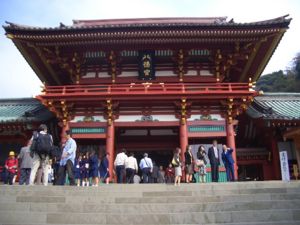
Tsurugaoka Hachimangu Shrine is the spiritual heart of Kamakura and one of its most popular attractions. The shrine was originally founded by Minamoto Yoriyoshi in 1063, in Tsurugaoka near the Yuigahama coast, but was moved to its current location in 1180 by Minamoto Yoritomo. The existing buildings, dedicated to Hachiman, the Shinto god of war and patron of the Minamoto family, date back to 1191, after the original structure was destroyed by fire.[4]
Wakamiya Oji, the cherry tree-lined pedestrian path to the shrine, was also constructed by Yoritomo back in the 1190s so that his oldest son's first visit to the family shrine could be accomplished in style with an elaborate procession.
The pedestrian lane stretches from the shrine all the way to Yuigahama Beach, with three massive torii set at intervals along the route to signal the approach to the shrine. On both sides of the pathway are souvenir and antiques shops selling lacquer-ware, pottery, and folk art.
The shrine's grounds cover some 80,000 square meters and house numerous smaller shrines, besides the main shrine. The latter is located at the head of 62 steps. A gingko tree to the left of the stairs is thought to be about 1,000 years old. The panoramic view from the top of these steps, looking back over the city towards the coast, is one of the highlights of any tourist's visit.
Other shrines found within the complex include the Hataage Benzaiten Shrine. Benzaiten is the Goddess of Fortune, Art and Learning. However, not being a genuine Shinto deity (but rather the equivalent to the Indian goddess of rivers and lakes), the Meiji Government did not recognise this sub-shrine and the existing one was only rebuilt in 1956. The name Hataage was added, meaning "to start a new venture". White banners fastened to the shrine indicate that many devotees attend to pray for prosperous businesses.
The most important dates on the shrine's calendar are:[5]
- New Year's Festival (1 - 3 January) which draws almost 2 million pilgrims over the three days;
- Chona Hajime Ceremony (4 January). Chona means an adz and hajime a beginning or first use. The ceremony is in commemoration of the ritual Yoritomo performed at the construction of the Shrine;
- Joma Shinji (5 January). Meaning "Exorcising Evil Spirits", archers dressed in traditional costumes shoot arrows at a target on which the letter oni (鬼) or devil is written. By shooting the target they wish the evil be exorcised.
- Setsubun (3 February). The "Bean-Scattering Ceremony" is held on what is seen as the last day of winter and is held to drive out bad luck and usher in good luck. Kamakura residents whose Oriental zodiac of birth year matches that of the new year are invited to throw lucky beans from the Ritual Dance Stage, dressed in traditional costumes.
- Oharae (30 June). The semi-annual Purification Ceremony. Participants write their names on a doll-shaped piece of paper, which is set adrift on the shrine's ponds. This is to atone for the sins they have committed during the preceding six months.
- Chikyu Festival for the Empress' Birthday (20 October)
- Shichi-go-san (15 November, or nearest weekend). Literally meaning "seven-five-three", this festival involves three-year-old boys and girls, five-year-old boys, and seven-year-old girls, who visit the shrine, accompanied by their parents, to pray for good health and good luck.
- Emperor's Birthday (23 December). A national holiday in Japan, the shrine celebrates the birthday, and prays for the continued good health of His Majesty.
- Second Oharae (31 December). As with the 30th June ritual, pilgrims atone for their sins, before making their first worship of the year after midnight and the start of the new year.
Kiri-doshi[edit]
A Kiri-doshi is, literally, a pass cut through a hill to enable overland travel and transportation of goods to and from the town. There were seven Kiri-doshi in Kamakura, all of which were constructed in the strategically important hills surrounding the city. The cuts are narrow, barely wide enough to enable a man on horseback to pass through; the passes were designed thus to prevent the enemy from rushing in.
Waka-ejima[edit]
Off the eastern part of Kamakura beach, there lies the remains of reclaimed land, called Waka-ejima. It was built in 1233 and served as an important man-made harbour during the Kamakura Period. Logs needed to repair the Tsurugaoka Hachimangu Shrines, among many others, were unloaded here. Today, the area is covered with piles of stones and reveals itself only at low tide.
Gorinto[edit]
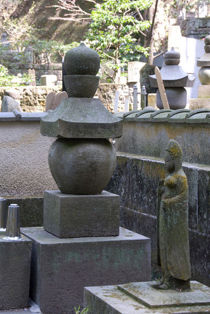
Translated into English as "five-tier-tomb" or "five-ring-tower", gorinto are grave markers, indigenous to Japan, erected for funerary purposes. They consist of five tiers of curved stone; each stone expressing one of the basic elements of the universe, which Buddhists believe created everything in the universe. The bottom stone is a cube, expressing the earth; the second is a sphere, representing water; atop this is a pyramid-like shape, representing fire; next is a semi-sphere, representing wind and it is topped by a peach-shaped hoju, representing the sky.
Ranging in height from one to four meters, gorinto first appeared during the middle of the Heian Period (794-1185) and many of them can be seen in Kyoto as well, but the ones made during the late Kamakura Period are regarded as being the most beautiful. These include Ninsho-to, built in 1303, Kakuken-to (1306), Enkei-san'nen-to (1310), and Gentoku-nin-to (1330).
Yofu'kuji[edit]
Yof'ukuji is one of the most famous ruined temples in Kamakura, located halfway along the road linking the Kamakuragu Shrines to Zuisenji. It was constructed by Yoritomo Minamoto, who modelled it after the Nikaido Hall of Chusonji, Hiraizumi. Yoritomo built this gorgeous temple for the salvation of the war-dead in 1194 and in its day, the temple was as glorious as the Tsurugaoka Hachimangu Shrine. Unfortunately, it burned down in 1405, but the 86,000 square meter site has been excavated since 1983, with the excavations uncovering the original foundations of the temple. It is an historic site, designated as such by the Prefectural Government.
Kotokuin Temple[edit]
The home of the Great Buddha of Kamakura, Kotokuin temple is a Buddhist temple of the Pure Land sect. The statue itself is a monumental outdoor bronze statue of Amida Buddha, and is one of Japan's most famous icons. The statue stands over 13 meters high and weighs approximately 93 tons.
The statue probably dates from 1252, in the Kamakura period, when temple records report the construction of a bronze statue. However, it is unclear whether that is the present statue. The statue was built inside a wooden temple but that building washed away in a tsunami sometime during the Muromachi period in the late fifteenth century.
See also[edit]
- Yokohama
- Kyoto
- Nagasaki
- Nara (Home of the largest statue of Buddha in Japan.)
- Gallery of Japanese Painting
External links[edit]
- Japan Atlas: Kamakura
- Kamakura basic information
- Kamakura Period A Chronology of Japanese History.
Notes[edit]
- ↑ The Great Buddha of Kamakura
- ↑ http://www.asahi-net.or.jp/~qm9t-kndu/annualev.htm
- ↑ http://www.kiis.or.jp/kansaida/sakai/sakai01-e.html
- ↑ http://guide.city.kamakura.kanagawa.jp/eng/stroll/scene/turuoka.htm
- ↑ http://www.asahi-net.or.jp/~qm9t-kndu/Hachiaev.htm
Categories: [Japanese Cities and Towns] [Japan] [Urban History] [Featured articles]
↧ Download as ZWI file | Last modified: 03/07/2023 05:08:42 | 25 views
☰ Source: https://www.conservapedia.com/Kamakura | License: CC BY-SA 3.0
 ZWI signed:
ZWI signed: KSF
KSF